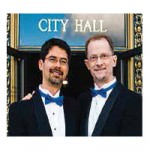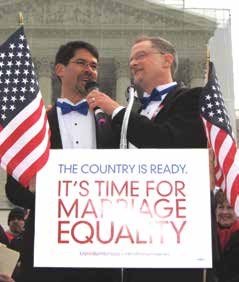 By John Lewis and Stuart Gaffney–
By John Lewis and Stuart Gaffney–
This week marks the tenth anniversary of the California Supreme Court’s historic May 15, 2008, ruling establishing marriage equality in California before Proposition 8. As one of the plaintiff couples in the case, we remember joining the other plaintiffs and hundreds of LGBTIQ supporters on the steps of the California Supreme Court that morning when at 10 am—the hour state Supreme Court opinions are announced—Kate Kendall, Esq., of the National Center for Lesbian Rights bounded out the doors of the Court proclaiming that justice had prevailed.
Cries of joy rang out and carried all the way to the top floor of the Supreme Court building, where the opinion’s author Chief Justice Ronald George could even hear them as he recalled in an interview later. As we hugged each other and all of those around us, Stuart’s cell phone suddenly rang. It was his mother, and she had just one question: “When’s the wedding?!”
That night, as we made our way home through the Castro, we joined thousands of people, celebrating in the streets until the wee hours.
The victory for the dignity of all LGBTIQ people when it comes to marriage was huge. Thanks to that ruling, all Californians enjoyed a fundamental state constitutional right to marry the person they loved—regardless of their race, religion, creed, national origin, gender, sexual orientation or gender identity. A person’s fundamental right to marry and to have the highest state recognition and protection for their relationship depended upon their humanity—and their humanity alone—and not on any external factor as to the class of people to which they could be categorized.
Every LGBTIQ person, regardless of which initial described them, could marry the person they chose because the state was not in the business of excluding couples from marriage based on who they are or whom they love. The state did not even ask marriage license applicants their gender. All LGBTIQ Americans now have this fundamental right by virtue of the United States Supreme Court’s 2015 decision. The California Supreme Court led the way.
As if that weren’t enough, those celebrating on May 15, 2008, had something of even broader importance to cheer in the Supreme Court’s opinion. The California Supreme Court did not just make a narrow ruling as to marriage equality (as the Massachusetts Supreme Court had done four years before). It made a sweeping declaration that lesbian, gay and bisexual people, just like other groups who have historically faced discrimination, are entitled to the highest degree of protection under the state constitution. State and local laws that discriminate on the basis of sexual orientation are presumptively unconstitutional and can stand only if the state demonstrates a most compelling reason, narrowly tailored, for the law—just like laws that discriminate on the basis of race, religion or gender.
This ruling applies to every way in which California state and local governments and their officials and employees relate to lesbian, gay and bisexual people, and the Court recognized that marriage was just the particular example of discrimination before it. The Court held that, under state law, excluding same-sex couples from marriage “marks” lesbian, gay, and bisexual people as “second-class citizens.” The same would be true of any law that unjustifiably treats lesbian, gay, and bisexual people differently from everyone else. This aspect of the Court’s ruling protects lesbian and gay people if a public school, police department, or any other California state or local governmental entity discriminates against them.

The status of being a protected class under the state constitution is an invaluable protection—something for which the community had fought for decades. Just as the California Supreme Court ten years ago became the first state supreme court to declare that LGBTIQ people had a fundamental right to marry, it was the first to recognize sexual orientation as a protected class. Establishing this status at a federal level for all LGBTIQ people is a top legal priority. The United States Supreme Court in its 2015 marriage equality decision laid the groundwork for such a future decision, but it did not go that far.
In reflecting on the decade since the California decision, we realized we have become accustomed to having our state constitutional rights, and it feels good. It affects the way we are able to live our lives, and it feels natural to embody that dignity.
We are not complacent. We know there are ongoing threats to our rights, and much more remains to be done in California, across the nation and around the world.
The California Supreme Court wrote ten years ago that every Californian should have the “opportunity to live a happy, meaningful, and satisfying life as a full member of society” and the state constitution “guarantee[s] this basic civil right to all individuals and couples, without regard to their sexual orientation.” Everyone everywhere should be able to live their lives with this dignity and hope. The Supreme Court’s decision will remain an important legal precedent and continue to inspire us as we move forward together to realize that dream.
Stuart Gaffney and John Lewis, together for over three decades, were plaintiffs in the California case for equal marriage rights decided by the California Supreme Court in 2008. Their leadership in the grassroots organization Marriage Equality USA contributed in 2015 to making same-sex marriage legal nationwide.
Recent Comments